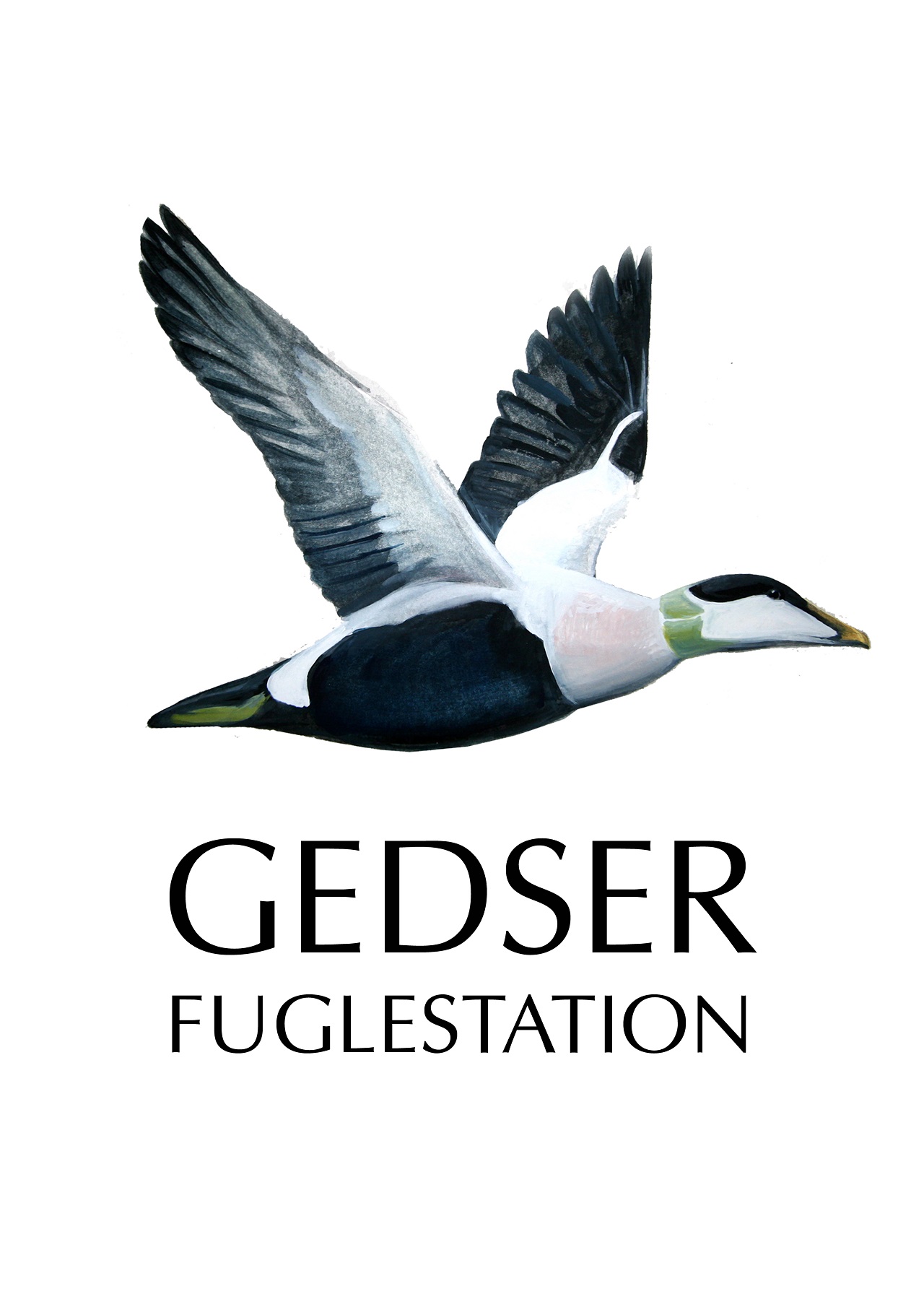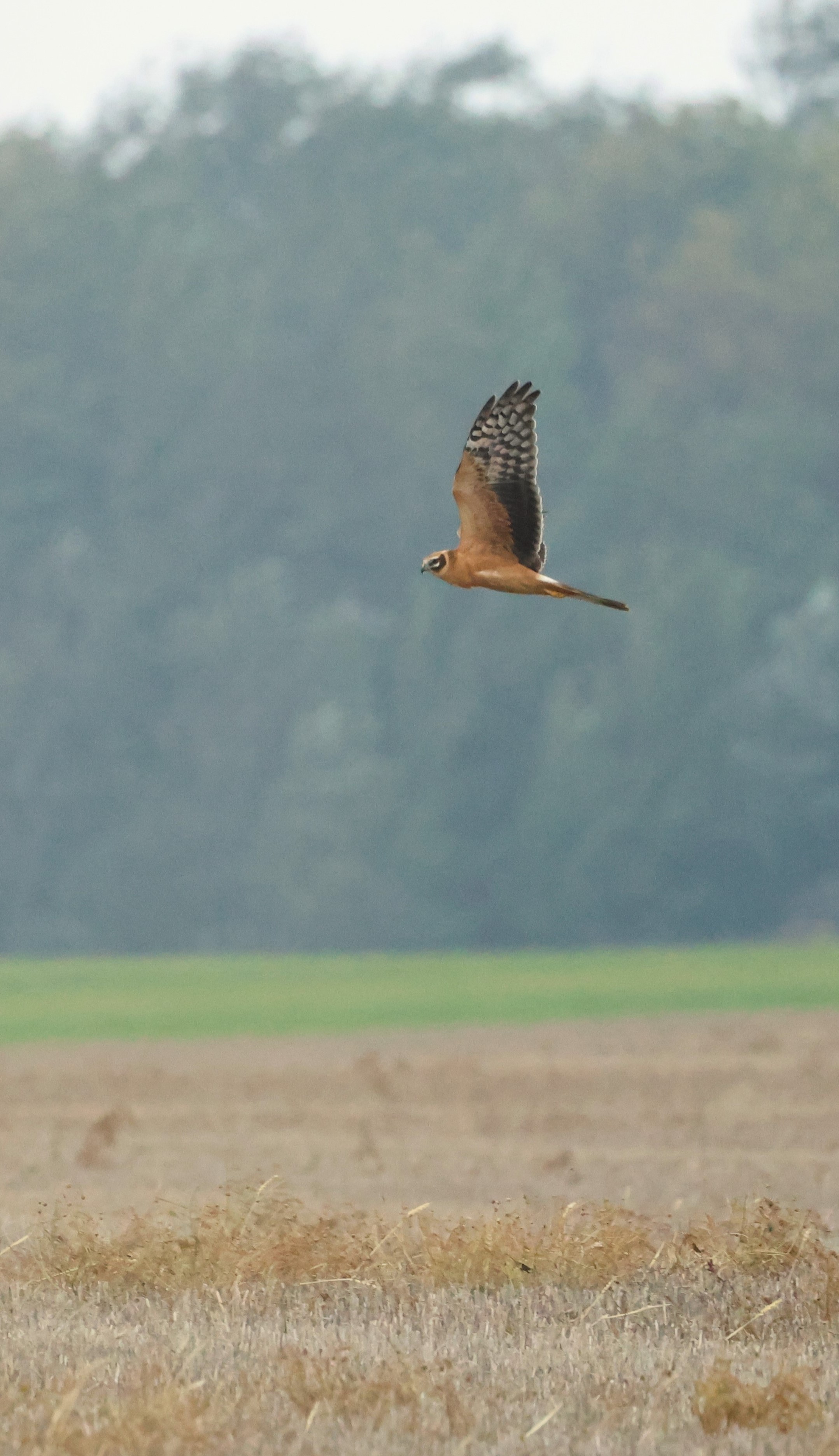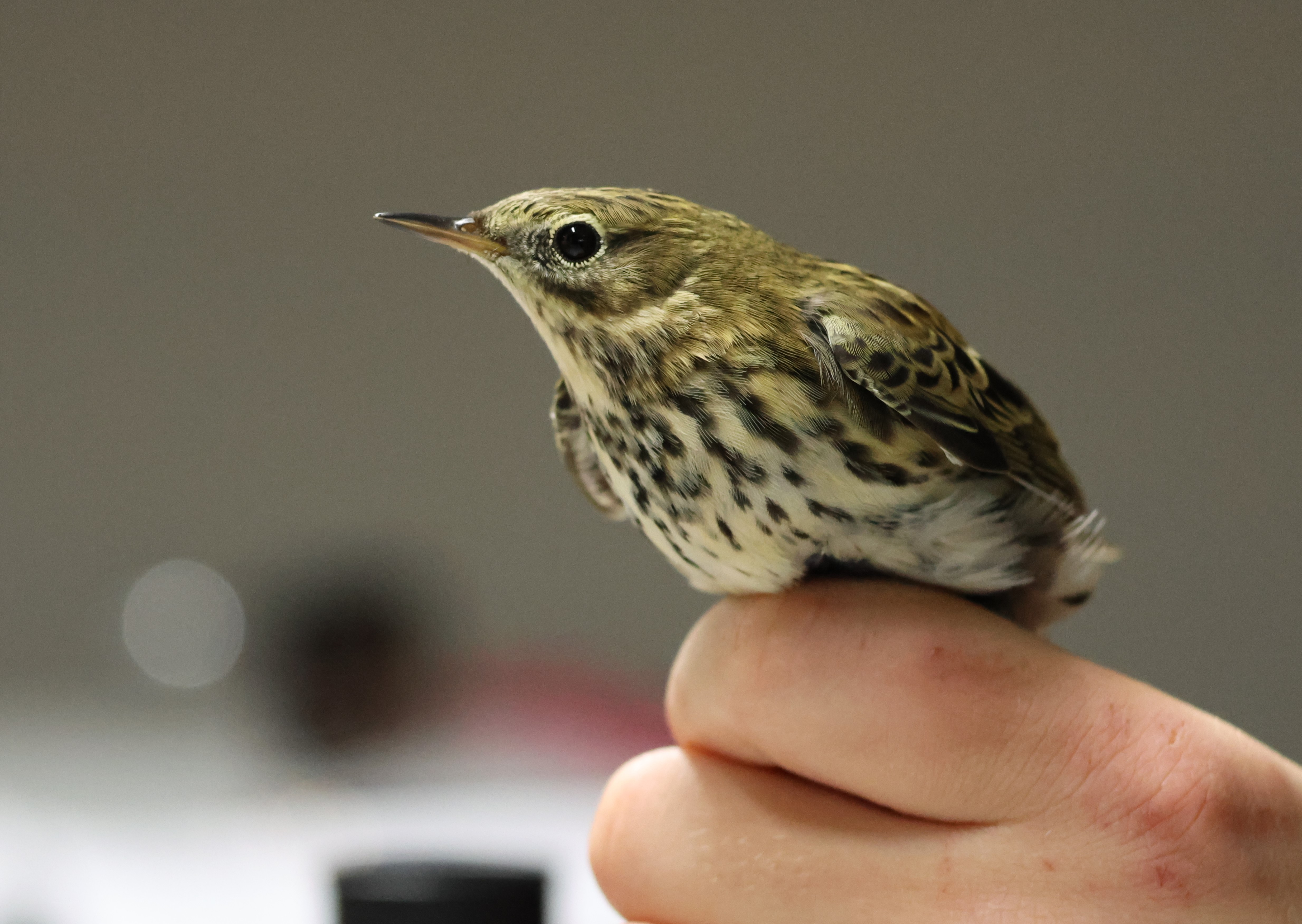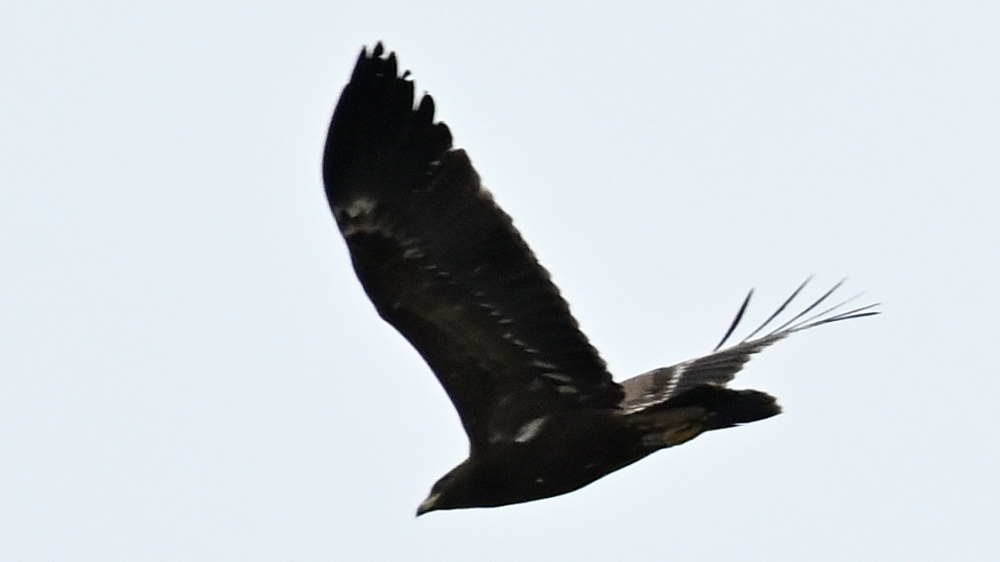Gedser Fuglestation Blog
Her på Gedser Fuglestations blog bringes korte nyheder i dagbogsformat om hændelser på fuglestationen.
Nærkontakt med en ikke helt Almindelig Kjove

Ringmærkningen:
Der blev fanget circa samme antal fugle som i går, men af flere forskellige arter. Jernspurv (Dunnock) og Rørspurv (Reed Bunting) trak i højere antal i dag sammenlignet med de sidste dage, hvilket afspejler sig i fangsten af de arter. Allerede før første runde gik en spurvehøg i nettet. Selvom den nok ikke havde regnet med at blive håndteret af mennesker i dag, lod den i hvert fald ikke skinne igennem, hvis den var bange.

Dagens ringmærkning og kontroller / Todays ringing and recaptures:
Spurvehøg/Sparrowhawk 1/0
Gærdesmutte/Wren 2/0
Jernspurv/Dunnock 4/0
Sangdrossel/Song Thrush 2/0
Vindrossel/Redwing 1/0
Munk/Blackcap 2/0
Fuglekonge/Goldcrest 5/2
Blåmejse/Blue Tit 2/0
Musvit/Great Tit 3/0
Bogfinke/Chaffinch 4/0
Kvækerfinke/Brambling 1/0
Rørspurv/Reed Bunting 1/0
Total 28/2
Trækket på Odden: En suveræn overraskelse gjorde søndagen til en særlig dag på landets sydspids. Der var ellers mange odds for det modsatte. Med en vejrudsigt, der lød på hård vind med silende morgen- og søndagsregn, satsede flere af de faste weekendfolk på en tur til Sjællands nordkyst, og mange var sikkert allerede trukket til Blåvand for at deltage i efterårsferiens traditionelle felttræf der.
Regnen udeblev dog, og odden kom til at byde på et spredt træk af hav- og landfugle, igen med tusindvis af Sjaggere (Turdus pilaris), Vindrosler (Turdus iliacus) og finker, men dem blev der ikke tid til at registrere, fordi prioriteten af havtrækket krævede koncentration om flokkende af Ederfugle (Somateria mollissima), der fløj spredt og langt ude i havgusen, hvor det var svært at skelne mellem hanner og hunner med ungfugle.
En brunlig fugl, der vendte ind over skraldeskuret ved den gamle marinestation, blev ud af øjenkrogen ignoreret som en ung måge, men hov? Unge måger har ikke et stort lyst felt på håndfladen af en ellers mørk vinge, og så kom 'mågen' heldigvis forbi igen, landede på marken og blev aldeles uventet til en Almindelig Kjove (Stercorarius parasiticus). Vi er vant til Almindelige Kjover på forbitræk. Vi ser dem mest på temmelig stor afstand og ofte i modlys eller anden dårlig belysning. Inde på land er de et yderst sjældent syn. Et kollegialt alarmopkald til ringmærkerne inde på stationen fik Timon af sted på en cykel, og senere kom Gert Juul Jeppesen til, så pludselig var vi flere fuglefolk på odden om en usædvanlig oplevelse. Kjoven var stadig på marken ved odden og blev set gennem flere timer også af andre interesserede.

Måske mindede marken med den nyspirede vintersæd om tundraen, hvor den kom til verden tidligere i år, og tilsyneladende trængte den bare til en ’slapper’. Den fløj fint flere gang og virkede ikke sky. På Gedser Odde var vi begejstrede over, at den ind imellem fløj bare få meter forbi os. Kun en ung Vandrefalk (Falco peregrinus) kunne et øjeblik få den på vingerne og flugt ud over havet, hvor falken fortsatte og kjoven hurtigt vendte om for at lande på marken igen. Spurvehøge (Accipiter nisus) fløj få meter forbi uden at skulle have gang i et slagsmål med kjoven, som heller ikke tog notits af dem.

Lad det være en blank tilståelsessag. Kjovens sjældne nærvær kom helt sikkert til at påvirke kvaliteten af træktælleriet i flere timer, og der røg sikkert en del fugle usete forbi – men ikke i massevis. Ud over et havtræk af Ederfugle, som rundede de tusind, var der tilløb til et pænt træk af rovfugle med Musvåger (Buteo buteo), et par Røde Glenter (Milvus milvus), to Blå Kærhøge (Circus cyaneus) lidt Spurvehøge og et par Tårnfalke (Falco tinnunculus), og så var der, som nævnt, et imponerende, men for en enkelt observatør uoverkommeligt træk af småfugle.
Det kan også blive en fin mandag. Hvem kan forudse, hvad der kommer efter sådan en søndag?

Se alle dagens observationer fra Gedser Odde i DOFbasen.
Folk på stationen: Timon Grove Sørensen, Timmy Micallef, Henrik Jørgensen, Lars Ulrich Rasmussen, Ole Friis Larsen.
En ok dag
Gransanger (Chiffchaff) i morgenlyset
Efter gårdagens kæmpe drosseltræk var der stadig efterdønninger med lidt flokke hvor de fleste var sjagger, men det var meget langt fra gårdagens.
Første runde gave næsten 20 fugle (da de blev trykket ned af lidt regn) og resten af dagen var med enkelte fugle.
Grønirisk (Greenfinch) - en farveekplosion
31 fugle blev ringmærket og det må man sige er godkendt med den hårde vind som der var, og 5 fugle fra de foregående dage blev aflæst.
Dagens træk fra Odden kan ses på dofbasen og trektellen.
Lille Gråsiskener (Lesser Redpoll) dukkede op i lidt større antal i stationshaven i dag
Dagens ringmærkning og kontroller / Todays ringing and recaptures:
Gærdesmutte/Wren 4/0
Rødhals/Robin 1/2
Solsort/Blackbird 0/1
Vindrossel/Redwing 1/0
Gransanger/Chiffchaff 8/0
Fuglekonge/Goldcrest 11/2
Blåmejse/Blue tit 2/0
Bogfinke/Chaffinch 1/0
Kvækerfinke/Brambling 1/0
Grønirisk/Greenfinch 1/0
Dompap/Bullfinch 1/0
Total 31/5
På stationen: Timon Grove Sørensen, Ole Friis Larsen, Timmy Micallef, Henrik Jørgensen
Hitchcock live
What a day. Already when stepping out of the door this morning, it became clear to me that autumn has arrived for good - with strong gusts from the sea driving rainclouds and mist inland, and the calls of Redwings (Vindrossel) and Bramblings (Kvækerfinke) filling the fresh air. What I did not know was that this day would hold one of the greatest migration spectacles I've ever witnessed, performed by no other than the common and inconspicuous Fieldfare (Sjagger). Strap in!
Bird ringing / Ringmærkningen:
Redwing (Vindrossel) caught in the station garden
Already shortly after opening the nets at dawn, we caught both Redwing (Vindrossel) and Brambling (Kvækerfinke) - two highly anticipated ringing species for me. Rain showers soon forced us to close the nets and stop ringing for the day, but not before a female Firecrest (Rødtoppet Fuglekonge) was trapped, along with several small-sized passerines (see list below).
Two of four Bramblings (Kvækerfinke) ringed today
Firecrest (Rødtoppet Fuglekonge)
Dagens ringmærkning og kontroller / todays ringing and recaptures:
Solsort/Common Blackbird 0/1
Vindrossel/Redwing 3/0
Gransanger/Chiffchaff 2/0
Fuglekonge/Goldcrest 8/2
Rødtoppet Fuglekonge/Common Firecrest 1/0
Bogfinke/Chaffinch 2/0
Kvækerfinke/Brambling 4/0
Total: 20/3
Bird migration / Fugletrækket:
Already during the first rounds of checking our nets, the sky above us was filled with migrating birds. Thousands of Fieldfares (Sjagger) and Redwings (Vindrossel) passed overhead, joined by several species of finches (finker). It was a day of massive thrush migration that started at dawn and continued well into the afternoon. Defying the strong headwinds and rain, tens of thousands of birds passed by the bird observatory every hour and continued their journey across the sea.
A seemingly endless stream of migrating fieldfares, as seen from the lighthouse
Some of the thrushes rested on fields and meadows before crossing the sea
Up to 11.000 thrushes could be seen at the same time from the station
I (Timon) spent most of the day in front of the lighthouse, grappling with the numbers in an attempt to quantify and document this awe-inspiring natural phenomena. Using my pictures, videos and hour-by-hour monitoring of flocks as a clue toward the density and species composition of migrating thrushes/finches, I tried to estimate how many birds of each species migrated along the southern tip of Denmark today. The results were a staggering 128.250 fieldfares (sjagger) and 8.750 redwings (vindrossel) migrating at Gedser Odde between 7 am and 16 pm (and 100.000+ for the Brambling/Chaffinch pair).
I have never even come close to seeing this many thrushes before in a single day - and yet, I'm surprised by how close the estimates are to my "gut feeling" throughout the day. Despite the careful considerations and hours of monitoring put into this estimate, it is likely still far from the actual number of individual thrushes. Keeping this in mind, it may serve to give a glimpse of the magnitude of the migration spectacle that could be enjoyed at Gedser Odde this October 13th.
Pictures by Timon Grove Sørensen
Trækket på Odden: Efter tre dages fravær på grund af sygdom var det meget anderledes at komme tilbage til landets sydligste punkt fredag morgen. Formiddagen forløb med regn og rusk, og det var nødvendigt at klare tællingen inde fra ’dybet’ på den gamle marinestation, hvor vi har et meget begrænset overblik, men alligevel er det en luksus at kunne være både i læ og ly. Et forkomment Pindsvin midt ude på græsplænen blev bragt ind i tørvejr, hvor det livede op, rullede sig sammen og faldt i søvn i en interimistisk græsrede. Efter dagens tælling kom Pindsvinet med til fuglestationens have og blev lagt til rette godt inde under en busk. Her kan det forhåbentlig bedre klare sig.
Der var et ikke helt ringe havtræk, men langt under de tusindvis af Ederfugle (Somateria mollissima), der var i den seneste weekend. Til gengæld var det en af de få dage, vi oplever hvert efterår med tusindvis af drosler og finker. De trækker dagligt i tusindvis i denne tid, men som regel så højt oppe over Odden, at vi knap nok kan se dem eller slet ikke se dem. På enkelte dage med regn og rusk søger de nedad og giver et (sjældent) indblik i dette træk. Nogle gange samler de sig i tusindvis på marken ved Odden, når vejret er for hårdt, andre gange trækker de bare ud i lange bander, som de gjorde fredag formiddag.
En af de lokale udstillere på marinestationen sagde, at hun følte sig som i en scene af Alfred Hitchcocks film ’Fuglene’, der har været med til at gøre tusindvis af mennesker verden over lidt ængstelige for fugle i store flokke. Filmen om de skræmmende sorte fugle er baseret på en novelle, som engelske forfatter Daphne du Maurier skrev i 1953, efter at hun havde set en landmand pløje sin mark med en sværm af måger efter sig. Det er også et velkendt syn i dag, at måger sværmer efter en traktor for at tage de orme og larver, som ploven vender op af jorden. Om hun misforstod situationen eller brugte sin kunstneriske frihed til at lade fantasien råde er ikke til at vide, men historien påvirker stadig mange menneskers oplevelse af fugle i flokke.

Fredag var der flest Sjaggere (Turdus pilaris) i trækket – det er de grålige drosler, som også kommer i mange haver om vinteren for at æde æbler i slagsmål med Solsortene (Turdus merula). Dem blev der talt 27.000 af i løbet af standardtidens fem timer, men der var også nogle af de lidt større Misteldrosler (Turdus viscivorus) og en hel del af de mindre Vindrosler (Turdus iliacus). Dem blev der registreret 5.000 af i standardtiden. Endelig var der rigtig mange finker i blandede flokke af Bogfinker (Fringilla coelebs) og den mere nordlige Kvækerfinke (Fringilla montifringilla) med rødorange forvinger og mange af hannerne stadig (næsten) i den pragtfulde sommerdragt med knaldsorte hætter. Standardtiden gav næsten 11.000 af de to finkearter.
Tallene er naturligvis langtfra dækkende for trækkets størrelse, men de bidrager til at markere tidspunktet for dette store træk af finker og drosler. På Odden skal vi koncentrere os om havtrækket, så drosler og finker bliver kun talt, når der er tid til at kigge bagud ind over land – eller vi er flere folk til at deles om arbejdet. Desuden foregik fredagens tælling inde under halvtaget med et meget lille overblik over de fugle, der kom strygende fra land. Der kom også folk inde fra Gedser og spurgte om, hvad det var for en masse fugle, der også myldrede rundt inde over byen, så der er ingen tvivl om, at trækket af fugle denne formiddag var mange gange større end snævert over spidsen af Gedser Odde.
Timon fra fuglestationen brugte en del tid på at observere det særlige trækfænomen lige uden for fuglestationen. Han nåede til 128.000 Sjaggere mellem klokken 7 og 16.45 samt 8.700 Vindrosler og 100.000 finker i samme periode.
Se alle dagens observationer fra Gedser Odde i DOFbasen.
Folk på stationen: Timon Grove Sørensen, Timmy Micallef, Henrik Jørgensen, Ole Friis Larsen.
Autumn migration continues with Blue Tits, raptors and a ringer from Sweden
Today's bird ringing total was a bit higher than anticipated, my first morning here in Gedser and we ended up with over 100 birds! Following quite strong winds at the start of the day, clearer skies and a drop in the gusts allowed for some good migration after all.
Plenty of finches namely Chaffinch, Brambling, Redpoll flocked over. Among them were several Parrot Crossbills, with five passing right over the bird station in the early morning. Other passerines such as Blue Tit and Great Tit were the most numerous species ringed today, however we did ring a couple of finches - two female Bullfinch. Many Sparrowhawk, plus fewer of other species like Common Buzzard, Red Kite and Hen Harrier were observed from the station garden.
Both migrating and foraging raptors could be seen above the meadows and fields north of the station. More than 80 Sparrowhawks, 26 Common Buzzards, 16 Red Kites and several Marsh and Hen Harriers passed through heading west, while a White-tailed Eagle and up to three Rough-legged Buzzards were seen resting or hunting close to the lighthouse.
Pictures by Timon Grove Sørensen
As a ringer mostly based in Falsterbo, Gedser is a new observatory for me. The migration and ringing are rather similar to what we experience in Falsterbo, perhaps as similar as possible given the vicinity of these observatories. Following two ringing trips to Blåvand in recent years, I was looking forward to visit Denmark again and assist with some more birding and ringing, but this time at a closer station compared to the west Danish coast. Just like in Blåvand, the Gedser team gave me a warm welcome yesterday afternoon. Special thanks to Tina and Hans for facilitating my visit!
I hope to be of continued help and learn from my new colleagues so far - Henrik, Timon, and Freya who left today but will soon return. It has also been great to finally catch up with experienced migration counter Ole, some nine years after last meeting him in my home country, Malta!
Dagens ringmærkning og kontroller / todays ringing and recaptures:
Stor Flagspætte/Great Spotted Woodpecker 3/0
Gærdesmutte/Wren 5/0
Rødhals/Robin 6/1
Munk/Blackcap 0/1
Gransanger/Chiffchaff 1/0
Fuglekonge/Goldcrest 8/4
Blåmejse/Blue tit 74/1
Musvit/Great Tit 18/0
Dompap/Bullfinch 2/0
Total 117/7
På stationen: Ole Friis Larsen, Freya Mørup-Petersen, Henrik Jørgensen, Timon Grove Sørensen, Timmy Micallef
Meget vind og få, men fine fugle
I dag blæste det meget i Gedser med over 10 m/s hele dagen igennem. Det satte fugletrækket på pause og kun få sangfugle opholdt sig i haven, så der kun blev ringmærket 14 fugle i alt (6 genfangster). Vi var dog heldige at fange en voksen Stor Tornskade, allerede den anden af denne art i løbet af tre dage.
Om eftermiddagen tog jeg (Timon) på en cykeltur i området, for at prøve at finde fugle, der sad og ventede på bedre vejr. Efter et stykke tid fik jeg øje på en mellemstor rovfugl på en mark, der så lovende ud med det samme. Jeg sneg meg ind på den og fik taget nogle billeder, inden den fløj afsted på 120 meters afstand. En fin 1K steppehøg!
Da det er første gang, jeg skriver blogindlægget for Gedser fuglestation, vil jeg fortælle lidt om mig selv:
Jeg hedder Timon Grove Sørensen og er en 25-årig fugleentusiast. Jeg har kigget på fugle siden jeg var helt lille, og det har for det meste været i Tyskland og Israel, hvor jeg har boet, før jeg flyttede til Danmark i 2019.

Jeg har fået lyst til at blive bedre til ringmærkning, som indtil videre altid kun har været en lejlighedsvis fornøjelse. Nu har jeg glæden af at være på Gedser fuglestation i en uge, hvor jeg kan lære meget af de mere erfarne ringmærkere. Det har været 3 spændende dage siden jeg ankom, og det er nemt at stå op før solopgang hver morgen, når man glæder sig til de fugle, man skal ud og ringmærke.
Men det er ikke kun om formiddagen, vi ringmærker fugle. Siden i går har vi prøvet at fange fugle om natten, når de sover på stranden eller på marken. I dag var det en engpiber, vi fangede efter 3 timer i mørke, vind og regn. En lille fangst, men oplevelsen er jo allerede det hele værd. ;)
Opdatering:
Dagens ringmærkning og kontroller / todays ringing and recaptures:
Gærdesmutte/Wren 2/0
Rødhals/Robin 4/2
Sangdrossel/Song thrush 1/0
Munk/Blackcap 1/0
Gransanger/Chiffchaff 1/0
Fuglekonge/Goldcrest 3/3
Blåmejse/Blue tit 1/1
Stor Tornskade/Great grey shrike 1/0
Engpiber/Meadow Pipit 1/0
Total 14/6
På stationen: Ole Friis Larsen, Freya Mørup-Petersen, Henrik Jørgensen, Timmy Micallef, Timon Grove Sørensen
Formidling og fuglekonger
Vi satte stadig begrænset antal net op pga blåmejser men de kom kun i et lille antal(14 nye og 1 kontrol).
Ved ca 10 tiden kom en gruppe fra en højskole og fik lidt at vide om trækket og ringmærkningen ved Gedser odde. Senere kom Gert med en som nåede at få set lidt fugle i hånden også.
Første runde var god med både en del fuglekonger og gransangere, men desværre sluttede det meget hurtigt. Eneste fordel var så at vi mellem runderne kunne lave datatjek så alt nu igen er klaret.
Efter vi lukkede nettene fik Freya rengjort labbet.
Trækket på Odden blev ikke dækket i dag pga sygdom.
Dagens ringmærkning og kontroller/todays ringing and recaptures:
gærdesmutte/Wren 6/0
Rødhals/Robin 8/1
Solsort/Blackbird 1/1
Sangdrossel/Song thrush 3/0
Munk/Blackcap 3/0
Gransanger/Chiffchaff 28/2
Fuglekonge/Goldcrest 40/4
Blåmejse/blue tit 14/1
Musvit/Great tit 13/0
Korttået træløber/short-toed treecreeper 1/0
Total 117/9
På stationen: Ole FriisLarsen, Freya Mørup-Petersen, Timon Grove Sørensen, Henrik Jørgensen
En blodig debut
Morgenen gav ikke det forventede regnvejr, hvilket ikke bød på det småfuglefald, som vi regnede med. En stille og rolig dag med ringmærkning gik i gang, hvor vi havde lidt blandet med fuglekonger, gransangere og gærdesmutter. Hvad rødhalsene angik, var der meget få af i forhold til gårsdagen. Henrik hørte i løbet af de første par timer en hvidbrynet løvsanger, som vi håbede ville besøge et af nettene, men vi hverken så eller hørte mere til den efterfølgende.
Dagens overraskelse kom dog i løbet af formiddagen, da Henrik kommer ind med en ny ringmærkningsart til mig i form af en stor tornskade - en art, jeg har håbet på, da jeg ankom. Stor tornskade er berygtet for at være led ved hænderne og denne fugl var ingen undtagelse. Men på trods af nogle blodige bidemærker, ømme fingre og et par sagte tårer, var det det hele værd, for stor tornskade er en af mine yndlingsfugle.
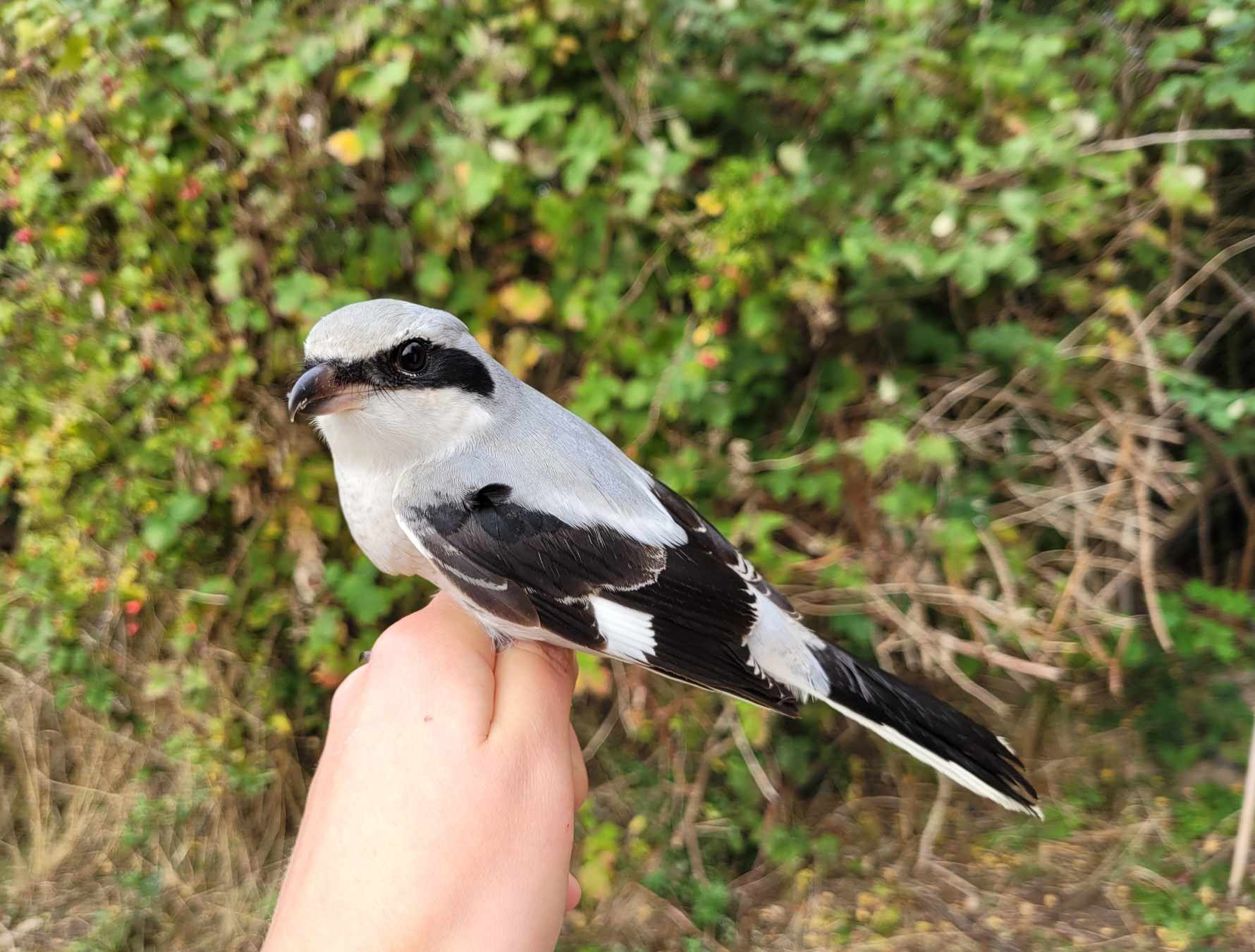
1k Stor Tornskade
Dagens ringmærkninger og kontroller/todays ringings and recaptures:
Gærdesmutte/Wren: 7/1
Jernspurv/Dunnock: 1/0
Rødhals/Robin: 8/0
Sangdrossel/Song Thrush: 1/0
Gransanger/Chiffchaff: 10/0
Fuglekonge/Goldcrest: 19/4
Stor Tornskade/Great Grey Shrike: 1/0
Bogfinke/Chaffinch: 1/0
Dompap/Bullfinch: 1/0
I alt: 49/5
Ederfugle, Traner og Rødhalse
Ringmærkningen:
Vi havde regnet med stort antal fugle i dag, men kun første runde gav stort antal og der efter var det omkring 10 pr runde. Grunden til at der ikke kom det store fuglefald som forventet er nok pga det helt klare vejr og så er fuglene bare trukket igennem.
Lidt sjovt i fangsten var der også hvor hele 3 store flagspætter blev fanget. Langt oppe i Sverige har de også meldt om flere spætter end normalt.
Tager man fangsten her i Gedser med 135 og tager Langeland hvor de fik over 400 er det en kæmpe forskel, men måske har de haft lidt skyer som så har gjort at fuglene gik ned.
Nu til aften forsøger vi at fange ugler, men ingen i skrivende stund.
I nat kommer der lidt regn sent og det kan godt give en del fugle i morgen da regnen stopper ved solopgang og regnen ligger sig over Tyskland.
Dagens ringmærkning og kontroller/Todays ringing and recaptures:
Stor flagspætte/great spotted woodpecker 3/0
Gærdesmutte/Wren 12/0
Jernspurv/Dunnock 1/0
Rødhals/Robin 39/0
Sangdrossel/Song thrush 1/0
Munk/Blackcap 2/0
Gransanger/Chiffchaff 33/0
Fuglekonge/Goldcrest 35/0
Blåmejse/Blue tit 3/1
Musvit/Great 1/0
Træløber/Treecreeper 1/0
Grønirisk/Greenfinch 3/0
Rørspurv/Reed bunting 1/0
Total 135/1
Trækket på Odden: En smuk søndag med godt selskab af rigtig mange fuglefolk på odden, inklusive fem medlemmer af bestyrelsen i NABU’s ornitologiske gruppe i Schwerin, som havde valgt Gedser Fuglestation som mål for deres årlige weekendtur. De fik dagen til at begynde tidligere end normalt med deres begejstring for stjernehimmelen over Gedser Odde, da vi stod op med udsigt til stjernebilledet Orion, planeten Venus, Månen og et mylder af blinkende stjerner i den kolde, men også klare luft.
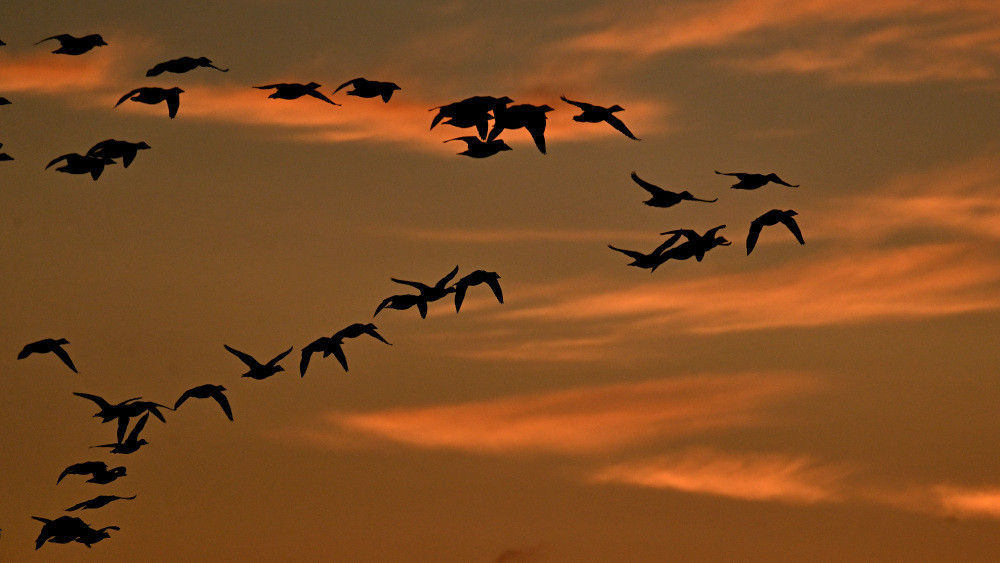
Efter en lørdag med Lille Skrigeørn (Clanga pomarina), Høgesanger (Curruca nisoria) og Alpesejler (Apus melba) bød søndagen ikke på rarieteter, men der blev dog indtastet observationer af 72 arter af fugle – rundt regnet en fjerdedel af, hvad der i al almindelighed forekommer i Danmark, og derfor er kedelige dage på landets sydligste punkt egentlig en sjældenhed. Mange nød dagens store træk af Ederfugle (Somateria mollissima), som satte ny rekord for dette efterår med lige over 13.000 i løbet af seks morgen- og formiddagstimer, og for de allermest udholdende nåede helt op på 15.800 i løbet af eftermiddagen.

Værd at bemærke var også et fint træk af Traner (Grus grus) og to arter af lommer, mens et træk på over 34.000 duer nok mere var fjerntælling for feinschmeckere i prikornitologi.
Se alle dagens observationer af 92 arter fra Gedser Odde i DOFbasen.
Folk på stationen: Freya Mørup-Petersen, Timon Grove Sørensen, Henrik Jørgensen, Ole Friis Larsen.
Høgesanger, Lille Skrigeørn og Ederfugle
Ringmærkningen:
Dagen startede med kraftig vind, men den ville stilne af hurtigere end forventet. Allerede fra morgenstunden var der godt med småfugle og allerede på åbningsrunden fangede vi en håndfuld fugle, heriblandt en fin vindrossel og en grønsisken.

Vindrossel
Formiddagen gik og der blev mange forskellige arter, heriblandt sæsonens to første dompapper og en stor flagspætte, som havde fløjet rundt i fyrhaven hele morgenen. Desuden var der en god portion blåmejser at holde os beskæftiget med. Da standardtiden var slut, besluttede vi os for at lade nettene blive op lidt længere.
Jeg gik første runde efter standardtiden var slut og opdagede en større fugl i et af nettene. Da jeg nærmede mig, kunne jeg se, at det var en stor grå sanger med lyse 'skæl' over vingerne og overgumpen og da gik det op for mig, hvad det var: En uventet og meget sen høgesanger. Jeg fik lov til at ringmærke den og derefter blev den overraskende fangst vist frem, før den fløj videre på sin færd.

1k høgesanger - en af de seneste for stationen, kun overgået af en fangst fra 8. oktober 2018
Så på ringmærkerfronten var dagen været ganske fantastisk og med mange forskellige arter.
Dagens ringmærkninger og kontroller/ todays ringings and recaptures:
Stor Flagspætte/Great Spotted Woodpecker: 1/0
Jernspurv/Dunnock: 11/0
Rødhals/Eurasian Robin: 26/0
Solsort/Common Blackbird: 0/1
Sangdrossel/Song Thrush: 3/0
Vindrossel/Redwing: 1/0
Høgesanger/Barred Warbler: 1/0
Munk/Eurasian Blackcap: 5/0
Gransanger/Common Chiffchaff: 17/0
Fuglekonge/Goldcrest: 6/0
Blåmejse/Eurasian Blue Tit: 61/3
Musvit/Great Tit: 1/1
Skovspurv/Eurasian Tree Sparrow: 1/0
Bogfinke/Eurasian Chaffinch: 2/0
Grønsisken/Eurasian Siskin: 7/0
Dompap/Eurasian Bullfinch: 2/0
I alt: 145/5
Trækket på Odden: Lørdag blev en gråvejrsdag, hvor temperaturen ikke nåede over 14 grader, og der bogstaveligt talt var efterår i luften med Bramgæs (Branta leucopsis) og Blisgæs (Anser albifrons) som nye sæsonarter, men det blev også en dag med hastigt faldende vind efter de seneste blæsende dage fra 10,8 meter i sekundet ved arbejdstids begyndelse lidt før klokken syv, til 4,1 meter efter en ekstra time i forlængelse af standardtiden.
Og så blev det en dag med flere fine overraskelser. Ringmærkerne fangede en ung Høgesanger (Curruca nisoria), som vi andre også fik glæde af at opleve inde ved fuglestationen. Ude på odden så vi et flot udtræk af Røde Glenter (Milvus milvus) og to Sorte Glenter (Milvus migrans) samt en ung Lille Skrigeørn (Clanga pomarina), der blev opdaget, da den kredsede lavt over marken ved odden sammen med en Rød Glente, og det umiddelbart var let at se, at det var en sjælden ørn i området, for den var tydeligt mindre end de Havørne (Haliaeetus albicilla), vi er vant til at se.
Et af flere gode kendetegn for Lille Skrigeørn til forskel fra Stor Skrigeørn (Clanga clanga) er et dobbelt 'komma' ved håndleddet/knopletten på undersiden af vingerne, hvor Stor Skrigeørn kun har et enkelt 'komma'. Her ses det dobbelte komma fint på ørnen, som trak ud fra Gedser Odde lørdag formiddag. På oversiden af vingen ses også, at forreste del af vingen med dækfjerene er lysere end de store svingfjer. De mange lyse fjerspidser på vingerne viser, at det er en ung ørn fra i år. Foto: Ole Friis Larsen/GFU
Skrigeørnen tog hurtigt højde og trak så målrettet og uden tøven ud over havet lige ved den gamle marinestation. Små Skrigeørne flyver til det sydlige Afrika om vinteren og er på farten det meste af året. Hvor den kom fra, og hvordan den er kommet til Sydfalster er ikke til at vide, men der er en chance for, at ørnen stadig kan møde artsfæller at trække sammen med ved ankomsten til Tyskland. Det er en central- og østeuropæisk ynglefugl, som det videnskabelige navn antyder – Pommersk Ørn. Den har sin vestligste udbredelse i Østtyskland, hvor bestanden længe er gået tilbage, men nu er stabil på omkring 120 ynglepar i Mecklenburg-Vorpommern og Brandenburg.
Imponerende var det også med en uventet stor dag i det klassiske træk af Ederfugle (Somateria mollissima). I standardtiden blev det til 4.964 fugle i et træk, som tog til i styrke hen over formiddagen, og alene i den ekstra time kom der så yderligere 3.501. Andre blev endnu længere på odden og nåede endnu højere tal. Fuglestationens tal på 8.465 var det største i de daglige tællinger i dette efterår, men så var det (desværre) heller ikke mere storslået.
Et kig på de seneste år registreringer af Ederfugle ved Gedser Odde viser stor variation for den første uge af oktober med 6.488 fra 2. til 7. oktober i 2021, 23.713 i samme uge i 2022 og i år 10.431 fra 2. til og med 7. oktober. Trækket lige nu er altså helt fint sammenlignet med 2021, men under det halve af samme periode sidste år. Det kan nås endnu.
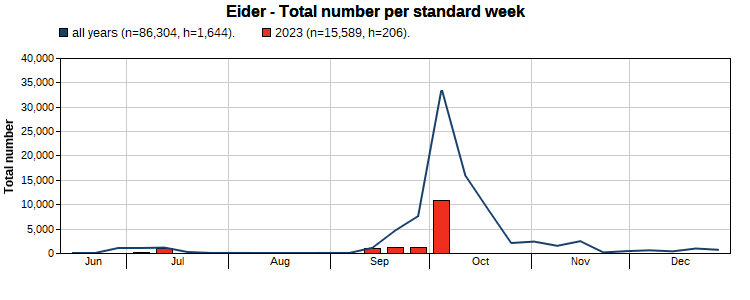
De røde søjler viser, hvordan trækket af ederfuglehanner i dette efterår har ligget langt under gennemsnittet ved Gedser Odde (kurven). Den seneste uges tiltagende træk svarer til årstiden, men er stadig under det halve af gennemsnittet. Kilde: Trektellen
Andelen af brune fugle (hunner og deres unger fra i år) har for hele ugen været på 5,2 procent. Det er lavere end i 2022 med 6,3 procent. Heller ikke det er noget, der ikke kan rettes op på i de kommende uger, men grafikker på basis af vores indtastninger i den nederlandske trækfugledatabase Trektellen gennem flere år viser, at vi skal være opmærksomme på risikoen for, at det stadig store træk af Ederfugle ved Gedser Odde viser en faldende tendens. Derfor er det vigtigt, at vi bliver ved med at følge trækket tæt.
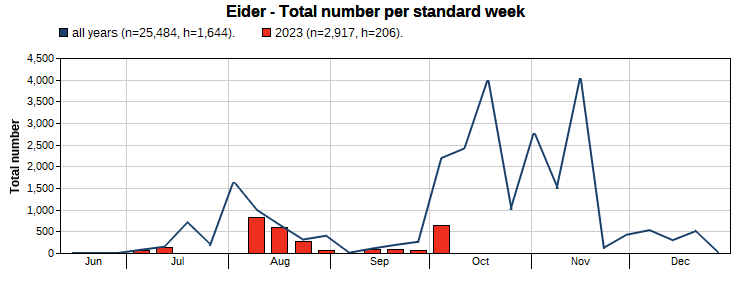
Trækket af brune hunner og deres unger ser mere normalt ud i forhold til gennemsnittet fra Trektellen i august og september, men er foreløbig lavt for oktober, selv om den procentvise andel af brune fugle i trækket er bedre end i 2022. Kilde: Trektellen.
Se alle dagens observationer af 92 arter fra Gedser Odde i DOFbasen.
Folk på stationen: Lone Madsen, Freya Mørup-Petersen, Lars Madsen, Lars Ulrich Rasmussen, Henrik Jørgensen, Ole Friis Larsen + fem gæster fra den tyske naturbeskyttelsesforening NABU's fuglegruppe i Schwerin.
Stille dag med datatjek og aftenfangst
Da der var regn på radaren og vinden tog mere og mere til valgte vi at holde nettene lukket. Men vi fik til gengæld så lavet alt det datatjek som der lå(og der var meget).
Til aften tog Freya og jeg ud på aftenfangst og vi nåede lige at stoppe 2 ravsamlere som vi nåede at stoppe så vi kunne kunne få et forspring. Vi nåede dog ikke langt op ad stranden og der mødte vi så et hold ravsamlere som kom mod os så intet blev fanget eller set.
Trækobservatøren var til møde i København efter standardtiden, så derfor ingen dagbog om trækket i dag.
På stationen: Freya, Lars, Henrik, Ole, og flere
